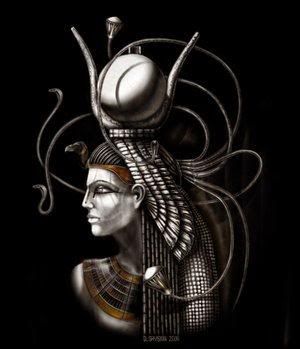From: "Let Them Eat Art" (114493383)
To: (218267874)
Date: 29/03/2010 11:03:03
Subject: Goddess: Isis-Egypt
Thanks to: PallasAthena (426627017)
Date: 29/03/2010 09:57:38
The Great Lady; Queen of Earth; Light Giver of Heaven; Mistress of Magic; The Many Named; Queen of the Throne; She Who Is Rich in Spells; Great of Sorcery; Redemptress; Star of the Sea; The One Who is All; Mother of Gods

Also known as Au Set (sometimes spelled Auset-English spelling)
Origin Egypt
Isis maybe the most venerated goddess on Earth. Venerated in Egypt for thousands of years, her worship eventually spread from East Africa throughout Western Asia and Europe as far as England’s Thames River.
Isis is so multifaceted that the Greeks identified her with Aphrodite, Artemis, Demeter, and Persephone. The story of Isis and Osiris, her beloved twin brother/soul mate, is among the most beloved romantic tragedies. Isis is the lady of many names and many forms. She is the beautiful young, privileged princess and the grieving, poverty-....stricken widow dressed in rags. She is the greatest sorceress on Earth, in possession of the Ineffable Name, the most powerful word in creation and the poverty-....stricken single mother in hiding, force dot beg to feed herself and her son. Isis maybe the unnamed narrator of the Gnostic poem, “Thunder, Perfect Mind.”
Isis is the most compassionate of deities because she has lived the life of an oppressed woman, she is the most powerful, because as Mistress of Magic, she knows all and can do all. Isis can resurrect the dead and can bestow the gift of fertility. She heals the ailing and protects travelers at sea. There is no miracle that she cannot perform.
Isis was a relatively late goddess to appear in Egypt, first emerging in the Nile Delta but rapidly, became on of the most beloved. Like Hathor, with whom she was identified, Isis is a cow-goddess. Her devotees traditionally refrain from consuming beef.
Veneration of Isis was officially introduced to Rome in 86 BCE, where she became extremely popular because, unlike other religions, her cult was open to all, including woman and slaves. Her spiritual tradition developed a bad reputation in conservative Rome, because of its alleged licentiousness,.... and was legally suppressed at least five times between 59 and 48 BCE.
Even after abolition of Paganism, veneration of Isis was extremely persistent. Her last official temple on the southern Egyptian island of Philae survived until 537 CE, when Narses, Commander of Emperor Justinian’s Egyptian troops, ordered it shut. Votive statues of Isis, Osiris, and Min were confiscated and sent to Constantinople..... Temple clergy was imprisoned. The walls of the shrine, previously adorned with images, were whitewashed, and the temple was converted to a Christian church.
Although Isis is mainly identified with ancient Egypt, the Romans carried her veneration throughout Europe. She became extremely popular in Gaul and was for substantial period the preeminent goddess of Paris. Paris was considered her city as Lyon belonged to Kybele. Isis was among the last Pagan deities to be actively venerated, and she was perceived as a primary competitor of early Christians.
In Lucius Apuleius’ second-century CE Roman novel, The Golden Ass, Isis tells the narrator that only Egyptians and Ethiopians call her by her true name (Au Set), but that she has countless names to which she answers. This may have been a tacit way of giving devotees permission to venerate her in other forms and under other names. Many believe that Isis assumed the mask of Mary, Mother of Christ. The earliest Christians statues of Mary were refurbished, renamed statues of Isis. Much Marian iconography is based on that of Isis. Many of Isis’ titles were bestowed on Mary as for instance Stella Maris; Theotokos, and Mother of God. Statues of Isis also traveled the Silk Road and may eventually have evolved into Kwan Yin.
Favored People Theoretically everyone, but especially women, single mothers, orphans, occultists, and mariners.
Manifestation Isis is an incredible magician can take any form she chooses. She may manifest as a cow, kite, or swallow. She may appear as a beautiful queen, a pregnant woman, or a woman absolutely devastated by despair and grief.
Iconography Isis is portrayed in many forms:
- Traditionally images of Isis are the prototype of the modern Madonna and Child. A woman, frequently carved from black stone, which in Egyptian cosmology represents eternal life, holds a nursing baby to her breast.
- She wears a crown topped by a throne (the meaning of her name, ”The Throne”)
- The Louvre Museum in Paris possesses a rare terra-cotta image of beautiful Isis weeping for her true love, Osiris
God and Goddess Allies Isis is frequently accompanied by an entourage of Gods and Goddesses, including; Anubis (........Anpu-....Egyptian), Nephthys, Heket (not to be confused with Hekate), Min, Bes, Khnum, Selket, Osiris (........Ausar-....Eyptian), Horus (her son-Heru in Egyptian), and the Scorpion Guardians. In general, Isis is friendly, gregarious goddess who will share her alter with anyone.

Emblem The tyet amulet (shown above), also known as the Buckle of Isis or Blood of Isis is a protective amulet usually formed from cornelian or red glass and representing the goddess’ menstrual blood-soaked sanitary pad: the power of life, death, and welfare.
Colors Black, blue
Element Water
Botanicals Vervain, myrrh tree, sycamore fig
Mineral Bloodstone
Metal Gold
Sacred Creatures Snakes, cows, crocodiles, scorpions, kites (type of raptor), swallow
Planet Moon
Constellation Virgo
Scared Sites There is a theory that the name Paris derives from Par-Isis, meaning the barque or grove of Isis. In Roman times, Isis had temples at the western limits of the city, the marshes on the Left Bank of the Seine. The churches of Saint Sulpice and Saint Germain-....des-Pres are built over sites once dedicated to Isis
Offerings Traditionally Isis accepts offerings of milk, honey, flowers, incense, and candles.

No comments:
Post a Comment